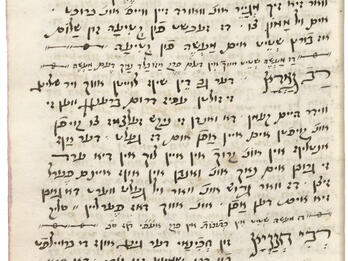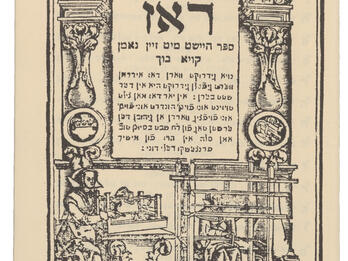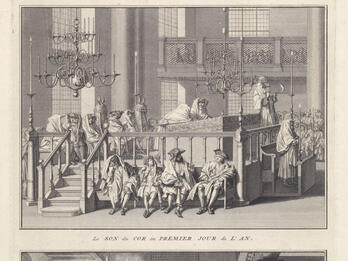Book of Fables
Moses Wallich
1697
Chapter XXXIV
The donkey greets the horse with his greeting. He says: “How is it that you are limping? Walk slowly to be sure you don’t fall. You’ll never be able to canter. You’ve surely grown old. Oh, oh, how bad you look. I think you’re not well. You’re as skinny as a dog, nothing but skin and bones. You certainly don’t have much to be happy…
Creator Bio
Moses Wallich
Little is known about the life of Moses ben Eliezer Wallich. He hailed from a famous family deeply attached to the community of Worms. His Sefer meshalim (Book of Fables) is, with some variations, a reprint of Ku-bukh (The Book of Cows) printed in Verona in 1595. Distinguishing this print from that made a century before is a letter of approbation from R. Joseph Samuel ben Tsvi of Kraków, then serving as a rabbi in Frankfurt, that this text is to be under copyright. Furthermore, Wallich identifies the thirteenth-century Isaac ibn Sahula’s Meshal ha-kadmoni (The Ancient Parable) and Berakhiah ben Natronai ha-Nakdan’s Mishle shu‘alim (Fox Fables) as the original sources for these fables in his title page. In the first preface, Wallich maintains that his book is also called Ku-bukh.
Related Guide
Early Modern Jewish Languages
As Ashkenazi and Sephardi Jews migrated eastward, Yiddish and Ladino emerged as distinct languages. Both languages developed literary traditions, as print became more widespread.
Related Guide
Early Modern Literature and the Arts
Jewish literary creativity flourished in the early modern period, dominated by Hebrew poetry that blended religious themes with Renaissance forms.
You may also like

Tales from the Mayse Book
The West Indian Tale
Ayelet ahavim (Hind of Love)
Sefer ma‘aseh nisim (The Book of Miracles)

Ku-bukh (Book of Cows)



